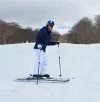I have watched several videos about going down slopes. Some say zig zag, some say keep knees bent, some say heel first, others forefoot first
So, how should you do a steep grade, loose rocks or gravel and muddy or rainy conditions.
Thanks for answering.
A few suggestions might help a bit.
1. Do not allow your feet to pound the ground. It hurts the knees. Shortening your stride and reducing your speed, which controls your momentum, is the key.
2. Keep your knees flexible and 'springy' by having them slightly bent. Doing so helps to absorb impact like a shock absorber does, rather than allowing your weight to drive the impact of the step into the knees, like the action of a jarring jack hammer.
3. On looser surfaces like sand and gravel that sit on the surface of a path or trail, I will step down on the outer edge of my heel first. This helps to force the weight of the step into a smaller area of the shoe or boot. This dramatically increases the ability of the footwear to force it's way through the ball-bearing detritus on top of the path to the firmer surface below. Even with a deep treaded, lug-style outersole, I will still step down heel edge first in these kinds of conditions.
The larger surface area of a shoe, like the fore foot and entire heel, coming into contact with the loose top covering of the path, increases the risk of the shoe or boot skating over the looser top covering of the path, which can cause slips and falls.
3. Trekking poles. They may help and assist with both issues above, and a lot of folks like them and use them effectively for downhills. I don't. I find that while I really like trekking poles for uphills and even on level terrain, I hate them on the downhill. They tend to interfere and get in the way.
However, even though i do not use them on the downhill, there are descents which are so steep and cluttered with layers of slippery top covering, like sand or gravel, that I will use them, slowly and carefully, to help assist me with controlling downhill momentum. Fortunately, that isn't an issue that happens very often.
So for downhill use, it is important to practice ahead of time to develop the rhythm and placement of the poles for them to be effective, and not a hazard.
























